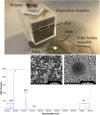Silver Microparticle-Enhanced Laser-Induced Breakdown Spectroscopy
- PMID: 35634979
- PMCID: PMC9411705
- DOI: 10.1177/00037028221096483
Silver Microparticle-Enhanced Laser-Induced Breakdown Spectroscopy
Abstract
Enhanced emission was observed in the laser-induced breakdown spectroscopy (LIBS) atomic emission spectra of bacterial cells deposited upon a nitrocellulose filtration medium in the presence of one-micron silver microparticles. A deposition chamber was constructed that allowed a uniform coating of the filter with trace amounts of silver microparticles. Masses from 10 to 100 μg were deposited in a circular area of 52.18 mm2. A 30 s deposition time was used for all experiments resulting in a mass deposition of 39 μg ± 17 μg. This mass coverage on the filter provided for a single laser shot silver mass ablation of 3.3 ng per laser shot. LIBS spectra were acquired with single-shot 1064 nm laser pulses from specimens of E. coli, M. smegmatis, and E. cloacae deposited on both microparticle-coated filters and blank filters. An increase in emission intensity for all elements detected in the bacterial LIBS spectrum as well as the carbon emission which derives in part from the nitrocellulose filter medium was observed due to the ablation with silver microparticles relative to the intensity measured from the ablation of bacterial cells deposited on a blank filter. The ratio of emission intensity with microparticles to emission intensity without microparticles was measured to be 3.6 for phosphorus, 4.5 for magnesium, 5.3 for calcium, 4.0 for sodium, and 1.2 for carbon. An enhancement in LIBS emission intensity in the range of 1-10 was observed for all the spectra, with an average enhancement ratio of 4.3.
Keywords: E. coli; LIBS; Laser-induced breakdown spectroscopy; bacteria; filtration medium; microparticles; silver.
Conflict of interest statement
Figures







References
-
- Rai V.N., Thakur S.N.. “Physics and Dynamics of Plasma in Laser-Induced Breakdown Spectroscopy”. In: Singh J.P., Thakur S.N., editors. Laser-Induced Breakdown Spectroscopy. Amsterdam: Elsevier, 2020.
-
- Aragón C., Aguilera J.A.. “Characterization of Laser Induced Plasmas by Optical Emission Spectroscopy: A Review of Experiments and Methods”. Spectrochim. Acta, Part B. 2008. 63(9): 893‐916. doi:10.1016/j.sab.2008.05.010 - DOI
-
- Jantzi S.C., Motto-Ros V., Trichard F., Markushin Y., et al. “Sample Treatment and Preparation for Laser-Induced Breakdown Spectroscopy”. Spectrochim. Acta, Part B. 2016. 115: 52-63. doi:10.1016/j.sab.2015.11.002 - DOI
MeSH terms
Substances
LinkOut - more resources
Full Text Sources

